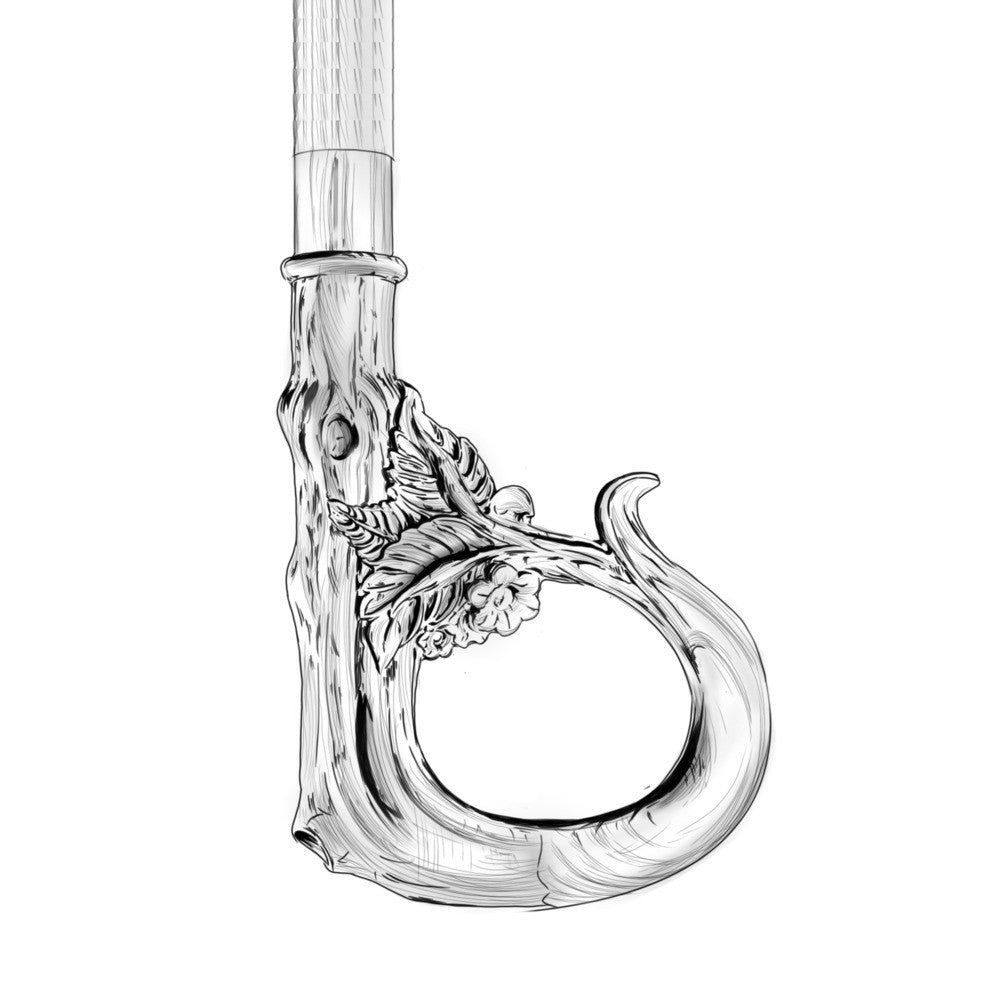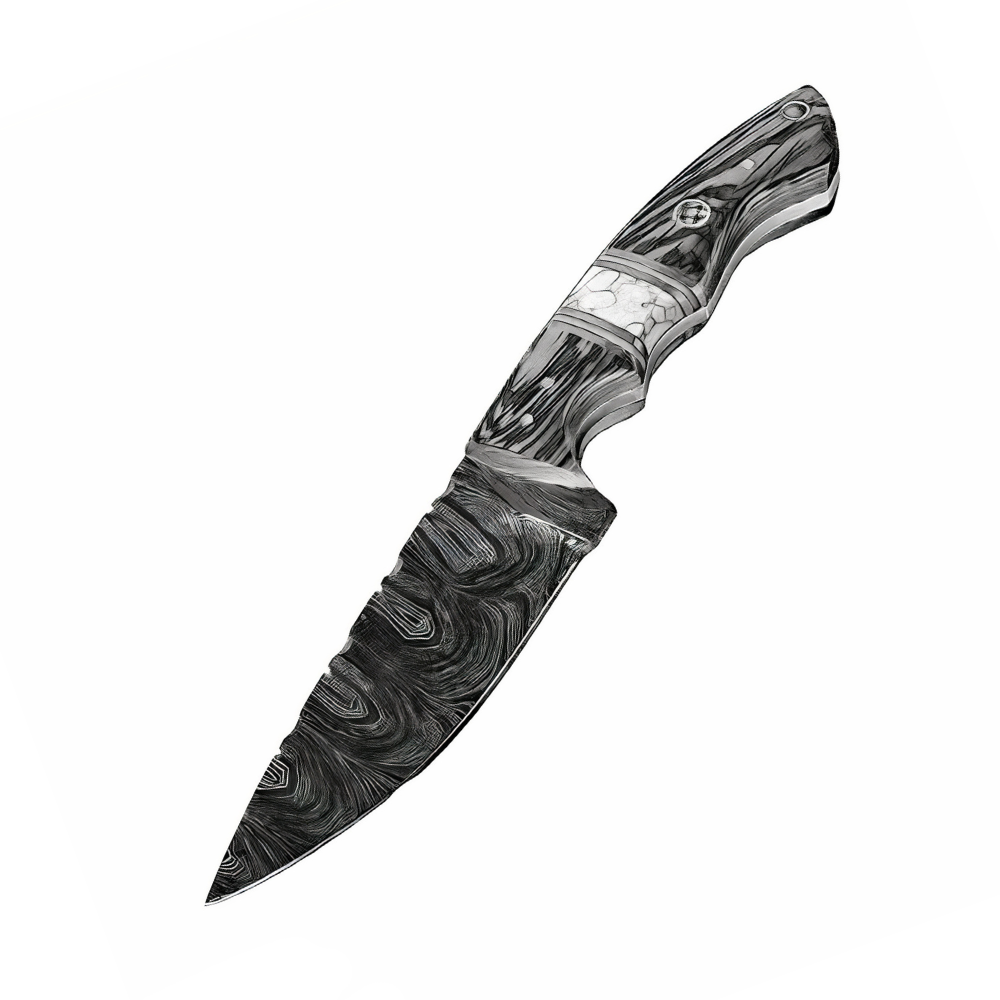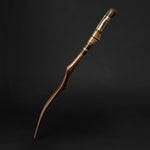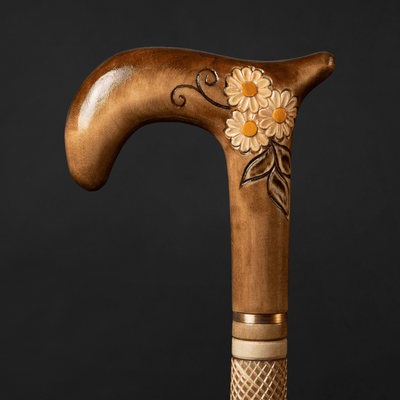You have no items in your shopping cart.
Recent Posts
-
The Art of Christmas Design: Walking Canes That Celebrate the Season in Style
-
How an Ergonomic Walking Cane Handle Prevents Hand and Wrist Strain?
-
How to Walk With a Cane Correctly to Avoid Back or Shoulder Strain?
-
5 Common Mistakes People Make When Buying a Walking Cane (and How to Avoid Them)
-
How to Choose a Walking Cane That Reflects Your Personality (Not Just Your Needs)?
-
Walking Canes That Match Formalwear for Weddings and Events
MOST POPULAR NOW
03
Apr
Walking sticks have been used for centuries, dating back to the time of our ancestors. They were initially used as a means of support for individuals with mobility challenges. However, over time, their uses have expanded, and they are now widely used during hunting and fishing expeditions. In this article, we will discuss the importance of using a walking stick during hunting and fishing, the benefits of using one, and a brief history of walking sticks.
The best walking sticks for hunting and fishing
Importance of using a walking stick during hunting and fishing
When it comes to hunting and fishing, the terrain can be rough and challenging to navigate. Uneven grounds, slippery surfaces, and steep slopes can cause you to lose balance, making it challenging to move around or aim correctly. This is where a walking stick comes in handy. A walking stick provides support and stability, helping you navigate through rough terrain with ease. It also allows you to move quietly and steadily, making you less noticeable to the prey you are hunting.
Using a walking stick during hunting and fishing also has safety benefits. It can help prevent accidents by providing support when crossing rivers, streams, or slippery rocks. It can also help you avoid tripping or falling when walking on uneven terrain or climbing steep hills.

Benefits of using a walking stick
Apart from providing support and stability, using a walking stick during hunting and fishing has several other benefits. Some of these benefits include:
-
Reduces fatigue - A walking stick reduces the strain on your joints and muscles, which can help you conserve energy and reduce fatigue. This is especially important when hunting or fishing for extended periods.
-
Improves balance - A walking stick provides additional points of contact with the ground, which can improve your balance and reduce the risk of falls or injuries.
-
Increases mobility - Using a walking stick can help you move around more comfortably and efficiently, allowing you to cover more ground during your hunting or fishing expeditions.
Brief history of walking sticks
Walking sticks have been used for centuries, with evidence dating back to ancient Egypt, Greece, and Rome. During the Middle Ages, walking sticks became a symbol of status and were often used as a fashion accessory. In the 18th and 19th centuries, walking sticks became popular among the wealthy and were often adorned with intricate carvings and designs. Today, walking sticks are still used as a symbol of style, but their functionality has become more important than their aesthetics.
Using a walking stick during hunting and fishing expeditions can provide numerous benefits, including support, stability, safety, reduced fatigue, improved balance, and increased mobility. The history of walking sticks is rich and varied, with evidence of their use dating back to ancient times. Whether you are a seasoned hunter or fisherman or a beginner, using a walking stick can significantly enhance your experience and help you achieve your goals.
Types of walking sticks for hunting and fishing
When it comes to hunting and fishing, having the right equipment can make all the difference. While many hunters and anglers focus on their firearms or fishing rods, one piece of equipment that is often overlooked is the walking stick. Walking sticks can be used for support, balance, and stability while traversing difficult terrain, and they can also serve as a useful tool for hunting or fishing. In this article, we will discuss the different types of walking sticks that are commonly used for hunting and fishing, including traditional walking sticks, folding walking sticks, telescoping walking sticks, and shooting sticks.
Traditional walking sticks
Traditional walking sticks are perhaps the most recognizable type of walking stick. They are typically made from a single piece of wood or bamboo, and they may feature a carved handle or other decorative elements. Traditional walking sticks are often seen as a fashion accessory, but they can also be useful for hunters and anglers. A sturdy traditional walking stick can provide support and stability when traversing uneven or rocky terrain. One of the disadvantages of traditional walking sticks is that they can be heavy and cumbersome to carry.
Materials used: wood, bamboo
Features: Carved handle, decorative elements
Advantages: Provides support and stability, can be used as a fashion accessory
Disadvantages: Heavy and cumbersome to carry
Folding walking sticks
Folding walking sticks are designed to be compact and easy to carry. They typically feature several sections that can be folded or collapsed for storage, and they may be made from a variety of materials, including aluminum or carbon fiber. Folding walking sticks are often preferred by hunters and anglers who need a walking stick that can be easily transported in a backpack or other gear bag. One of the disadvantages of folding walking sticks is that they may not be as sturdy as traditional walking sticks, and they may not provide as much support or stability.
Materials used: Aluminum, carbon fiber
Features: Collapsible, compact
Advantages: Easy to carry, can be stored in a backpack or gear bag
Disadvantages: May not be as sturdy as traditional walking sticks, may not provide as much support or stability
Telescoping walking sticks
Telescoping walking sticks are similar to folding walking sticks in that they are designed to be compact and easy to carry. However, telescoping walking sticks feature sections that slide into one another, rather than folding. Telescoping walking sticks are often made from lightweight materials, such as aluminum or titanium, and they may be adjustable to accommodate different heights. One of the advantages of telescoping walking sticks is that they can be adjusted to fit the user's height, which can provide more support and stability. However, telescoping walking sticks may be more expensive than traditional or folding walking sticks.
Materials used: Aluminum, titanium
Features: Adjustable, lightweight
Advantages: Can be adjusted to fit the user's height, lightweight and easy to carry
Disadvantages: More expensive than traditional or folding walking sticks
Shooting sticks
Shooting sticks are an essential tool for hunters and anglers who want to ensure a steady aim and a clean shot. These sticks can be used in a variety of hunting and fishing situations, from shooting game to landing a big catch. In this article, we will discuss the various types of shooting sticks available on the market, the materials they are made from, their features, and their advantages and disadvantages.
Materials used: wood, aluminum, carbon fiber, and fiberglass.
Features: stable and offer the support.
Advantages: they provide a stable base for the shooter, which helps to reduce movement and increase accuracy, they can also help to reduce fatigue, allowing hunters and anglers to maintain their focus and concentration for longer periods.
Disadvantages: they can be cumbersome to carry, especially if they are not collapsible; they can also be difficult to set up quickly, which can be a problem in fast-paced hunting or fishing situations: additionally, shooting sticks can be expensive, especially those made from high-end materials like carbon fiber.
Choosing the best walking stick for hunting and fishing
When it comes to hunting and fishing, having the right equipment is essential. A good walking stick can make a big difference in your ability to move through the terrain and maintain your balance while carrying gear. In this article, we will discuss the factors to consider when choosing a walking stick for hunting and fishing.
Weight:
The weight of your walking stick is an important consideration, as you will be carrying it for extended periods of time. A lightweight stick is ideal, as it will not add unnecessary strain to your arms or shoulders. However, it is important to balance weight with durability, as a stick that is too lightweight may not be able to withstand the rigors of outdoor use.
Length:
The length of your walking stick is also important, as it will affect your overall balance and stability. A stick that is too short may not provide enough support, while a stick that is too long may be cumbersome to carry. It is recommended that you choose a stick that reaches to your armpit when standing up straight with your arms at your sides. This will ensure that the stick is long enough to provide support, but not so long that it becomes unwieldy.
Durability:
The durability of your walking stick is critical, as it will be subjected to a great deal of wear and tear in the outdoors. Look for a stick that is made from a sturdy material, such as hardwood or aluminum. These materials are both strong and resistant to damage, making them ideal for use in the outdoors.
Comfort:
Comfort is another important consideration when choosing a walking stick. Look for a stick that has a comfortable grip and is easy to hold. Some sticks come with ergonomic handles that are designed to reduce strain on your hands and wrists. These are ideal for long hikes or extended periods of use.
Grip:
The grip of your walking stick is also important, as it will affect your ability to maintain your balance on uneven terrain. Look for a stick with a non-slip grip, such as one made from rubber or cork. These materials will provide a secure hold, even in wet or slippery conditions.
Matching the walking stick to the type of hunting or fishing:
Different types of hunting and fishing require different types of walking sticks. For example, if you are hunting in thick brush or wooded areas, you may need a shorter, more maneuverable stick. If you are fishing in a stream or river, you may need a stick with a pointed tip that can be used to probe the water and test the depth.
Matching the walking stick to the user's body type and preference:
Finally, it is important to choose a walking stick that matches your body type and personal preferences. Some people prefer a longer stick for added stability, while others prefer a shorter stick for ease of use. It is important to try out different options to find the one that feels most comfortable and natural for you.
In conclusion, choosing the right walking stick for hunting and fishing is an important decision that should not be taken lightly. Consider the factors outlined above, and take the time to try out different options before making a final decision. With the right walking stick in hand, you can move through the outdoors with confidence and ease.
How to use a walking stick for hunting and fishing?
Walking sticks are essential tools for hunters and anglers. They provide support and stability, making it easier to traverse rugged terrains while carrying gear. However, using a walking stick for hunting and fishing requires some knowledge of proper techniques and maintenance. In this article, we will explore the best ways to use a walking stick for hunting and fishing.
Proper techniques for using a walking stick
Using a walking stick properly can help prevent falls and provide stability on uneven surfaces. The proper technique for using a walking stick is to hold it with the opposite hand of the side that needs support. For instance, if you need support on your right side, hold the walking stick with your left hand.
When walking uphill, plant the walking stick uphill and step up with the opposite foot. When walking downhill, plant the walking stick downhill and step down with the opposite foot. This technique provides support and stability when navigating steep inclines or declines.
When crossing streams, use the walking stick to test the depth and stability of the stream bed before stepping in. To do this, plant the walking stick into the stream bed and lean on it slightly to test the stability of the footing.
Tips for using a walking stick in different terrains
Different terrains require different techniques for using a walking stick. In rocky terrains, shorter walking sticks with rubber tips can help provide stability on uneven surfaces. In muddy terrains, longer walking sticks with pointed tips can help penetrate the soft ground and provide support. In snowy or icy terrains, walking sticks with carbide tips can help provide traction and prevent slipping.
When crossing streams or wetlands, use a walking stick with a wrist strap to prevent it from being swept away by the current. Additionally, when traversing marshy areas, use walking sticks with large, flat bases to prevent them from sinking into the soft ground.
How to maintain and care for a walking stick?
Proper maintenance and care can help prolong the life of a walking stick. After each use, wipe down the walking stick with a damp cloth to remove dirt and debris. If the walking stick becomes wet, allow it to air dry thoroughly before storing it.
To prevent damage, do not leave the walking stick in direct sunlight or extreme temperatures. Additionally, avoid storing the walking stick in a damp or humid environment, as this can cause the wood to rot or warp.
A walking stick is an essential tool for hunters and anglers, providing support and stability while navigating rugged terrains. By following the proper techniques for using a walking stick and using the appropriate stick for the terrain, hunters and anglers can improve their safety and success while enjoying their outdoor pursuits.

Comparison of the different types of walking sticks
When choosing a walking stick for hunting and fishing, it's important to consider the type of hunting or fishing you'll be doing, as well as your personal preferences. Traditional walking sticks are a classic option that provides a sturdy and reliable walking stick. Folding walking sticks are a great option for those who require a more compact and easily transportable option. Telescoping walking sticks are a lightweight and adjustable option that is ideal for those who require a walking stick that can be easily modified. Shooting sticks are a versatile option that can also double as a shooting rest. Ultimately, the best walking stick for you will depend on your individual needs and preferences.
In conclusion, having the right walking stick can make all the difference when hunting and fishing. By considering factors such as weight, length, durability, comfort, and grip, you can find the perfect walking stick to suit your needs. Whether you choose a traditional walking stick, folding walking stick, telescoping walking stick, or shooting stick, you can be sure that you'll have a reliable and sturdy companion on your next hunting or fishing trip.
Accessories for walking sticks
Walking sticks are great tools for hunting and fishing, but they can be even more versatile with the right accessories. There are many accessories available for walking sticks, from attachments to cases to other add-ons that can improve your experience.
Attachments for walking sticks
One of the most popular accessories for walking sticks is an attachment that can be used to convert the stick into a monopod or tripod for stability. These attachments typically screw into the bottom of the walking stick and provide a stable base for your camera or binoculars, allowing you to take steady shots without the need for a separate tripod. Some attachments also have a swivel head, making it easy to pan and tilt your camera or binoculars.
Another popular attachment for walking sticks is a hunting or fishing rest. These attachments typically attach to the top of the walking stick and provide a stable platform for your gun or fishing rod, allowing you to take more accurate shots or make precise casts.
Cases and bags for walking sticks
Cases and bags are also popular accessories for walking sticks. These can help protect your walking stick during transport and storage, and make it easier to carry your walking stick with you on the go. Some cases and bags are designed to be worn on your belt or backpack, while others are designed to be carried by hand.
Other accessories for walking sticks
There are many other accessories available for walking sticks, including rubber tips for better traction on slippery surfaces, LED lights for better visibility in low light conditions, and even compasses or GPS units to help you navigate while on the go. Some walking sticks even come with built-in accessories, such as a built-in flashlight or a detachable fishing reel.
Overall, the right accessories can make your walking stick even more versatile and useful for hunting and fishing. Whether you're looking for improved stability, protection, or convenience, there are many options available to enhance your walking stick. Be sure to choose accessories that are compatible with your walking stick and that meet your specific needs and preferences.
In conclusion, the right accessories can help you get the most out of your walking stick for hunting and fishing. From stability attachments to cases to other add-ons, there are many options available to enhance your experience. Just be sure to choose accessories that are compatible with your walking stick and that meet your specific needs and preferences.

Tips for making your own walking stick
Walking sticks are not only essential tools for hunting and fishing but can also be works of art. Making your own walking stick can be a rewarding experience that allows you to create a unique and personalized tool for your outdoor adventures. In this article, we will provide you with tips and techniques for making your own walking stick.
Materials needed for making a walking stick:
The first step in making your own walking stick is to gather the necessary materials. You will need a piece of wood that is suitable for carving and shaping. The type of wood you choose will depend on your personal preference, but popular options include cedar, hickory, and oak. Other materials you may need include sandpaper, carving tools, a saw, and a finish.
Techniques for carving and shaping the stick:
Once you have your materials, you can begin carving and shaping your walking stick. The first step is to remove any bark or rough spots using sandpaper. Then, using a saw, you can shape the stick to the desired length and thickness. Be sure to wear gloves and eye protection while using the saw.
After shaping the stick, you can begin carving it. Carving can be done by hand or with power tools. If you are a beginner, it is recommended to start with simple designs and gradually progress to more intricate ones. Some popular designs include animals, flowers, and geometric patterns.
Finishing the walking stick:
After carving, it is time to finish your walking stick. The finish will help protect the wood and give it a polished look. Popular finishes include varnish, oil, and wax. Before applying the finish, make sure the stick is clean and dry. Apply the finish with a brush or cloth, following the manufacturer's instructions.
Tips for making your own walking stick:
- Choose a wood that is straight and free from knots or cracks.
- Use gloves and eye protection while working with tools.
- Start with simple designs if you are a beginner.
- Take your time and enjoy the process.
In conclusion, making your own walking stick is a fun and rewarding activity that allows you to create a personalized tool for your outdoor adventures. By following the tips and techniques in this article, you can create a unique and functional walking stick that will serve you well for years to come.
Conclusion
Walking sticks are versatile tools that can be incredibly useful when hunting or fishing. They provide stability and support on uneven terrain, help with balance while wading in water, and can be used as a support for shooting. In this article, we have discussed the different types of walking sticks for hunting and fishing, as well as their features and advantages.
Factors to consider when choosing a walking stick
When selecting a walking stick, there are several factors to consider, such as weight, length, durability, comfort, grip, matching the walking stick to the type of hunting or fishing, and matching the walking stick to the user's body type and preference. By taking these factors into account, you can choose the best walking stick for your needs.
How to use a walking stick for hunting and fishing?
Using a walking stick properly is essential to maximize its benefits. We have discussed the proper techniques for using a walking stick, tips for using a walking stick in different terrains, and how to maintain and care for a walking stick.
Reviews of the best walking sticks for hunting and fishing
There are several types of walking sticks available for hunting and fishing, including traditional walking sticks, folding walking sticks, telescoping walking sticks, and shooting sticks. We have reviewed the top options in each category, highlighting their features, advantages, and disadvantages.
Accessories for walking sticks
Accessories can enhance the functionality and convenience of walking sticks. We have discussed attachments for walking sticks, cases and bags for walking sticks, and other accessories that can make your hunting or fishing trip more comfortable.
Tips for making your own walking stick
For those who prefer a more personal touch, making your own walking stick can be a rewarding experience. We have discussed the materials needed for making a walking stick, techniques for carving and shaping the stick, and finishing options to ensure a durable and attractive walking stick.
Recommendation for the best walking stick
Overall, the best walking stick for hunting and fishing will depend on your specific needs and preferences. However, based on our reviews, we recommend the Shooting Stick as the best option for stability and support while shooting. For a more versatile option, the Telescoping Walking Stick is a great choice with its adjustable height and lightweight design.
In conclusion, a walking stick can be a valuable tool for any hunter or fisherman. With the right walking stick and proper use, you can increase your comfort and safety while out in the wilderness. Take the time to consider the factors that matter most to you, and choose a walking stick that will provide the support and stability you need.
Also Purchased
-
Beige Walking Cane for Ladies Chamomile Flower, Wooden Walking Stick
Introducing our beautiful Beige Walking Cane for Ladies with Chamomile Flower, a Wooden Walking Stick that is hand carved and handmade, making it both pretty and unique. This walking cane...$99.00$87.45 -
Exotic Burl Wood Walking Cane – Fashionable Artisan Stick
A sculptural statement in deep, oceanic blue — this walking cane is more than a support accessory, it's wearable art. Meticulously hand-shaped from stabilized burl wood, the handle evokes the...$467.50 -
ArtWalkingSticks™ MAGIC Walking Cane, Handmade - Make to Order
This piece of art is created for those who value details. We make one of a kind, handcrafted wood and resin canes. Our Wooden Canes are completely unmatched in creativity....$473.00 -
Umbrella with Eagle Handle, Fashion Umbrella For Men
Make a bold and fashionable statement with our Umbrella with Eagle Handle - a unique and functional accessory designed for men. The striking eagle handle is the highlight of this...$357.50 -
Fashionable Lion Shoehorn Long Handle, Pearly Brown Shaft, Handmade
Introducing our Fashionable Lion Shoehorn, a handcrafted, long-handled shoe horn with a pearly brown shaft that's both stylish and practical. The intricate Lion design adds a touch of elegance to...$264.00 -
ArtWalkingSticks™ MAGIC Red Walking Cane - Unisex, Handmade
This piece of art is created for those who value details. We make one of a kind, handcrafted wood and resin canes. Our Wooden Canes are completely unmatched in creativity....$467.50
































